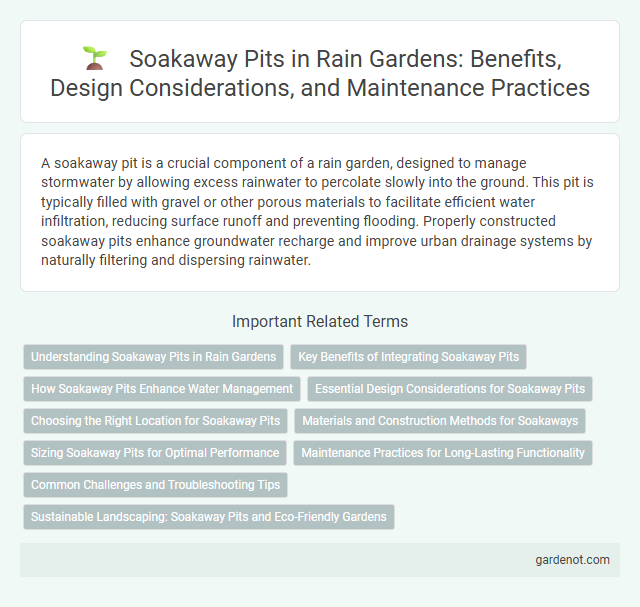A soakaway pit is a crucial component of a rain garden, designed to manage stormwater by allowing excess rainwater to percolate slowly into the ground. This pit is typically filled with gravel or other porous materials to facilitate efficient water infiltration, reducing surface runoff and preventing flooding. Properly constructed soakaway pits enhance groundwater recharge and improve urban drainage systems by naturally filtering and dispersing rainwater.
Understanding Soakaway Pits in Rain Gardens
Soakaway pits in rain gardens function as underground structures designed to facilitate rapid infiltration and drainage of stormwater runoff, minimizing surface water accumulation. These pits are typically filled with permeable materials such as gravel or crushed stone, creating void spaces that enhance water percolation into surrounding soil layers. Proper sizing and placement of soakaway pits are critical for optimizing rain garden performance and preventing waterlogging or soil erosion.
Key Benefits of Integrating Soakaway Pits
Soakaway pits efficiently manage stormwater by promoting natural infiltration and reducing surface runoff. They prevent flooding and groundwater contamination while recharging aquifers, enhancing urban water sustainability. Integrating soakaway pits in rain gardens improves soil moisture retention and supports healthy plant growth.
How Soakaway Pits Enhance Water Management
Soakaway pits significantly improve water management by facilitating rapid infiltration of stormwater into the ground, reducing surface runoff and mitigating flood risks. These pits act as efficient subsurface drainage systems that promote groundwater recharge and prevent soil erosion in rain garden landscapes. Implementing soakaway pits optimizes rainwater harvesting and supports sustainable urban drainage systems (SUDS) by managing excess water naturally and effectively.
Essential Design Considerations for Soakaway Pits
Soakaway pits must be designed with adequate depth and width to ensure efficient infiltration of stormwater while preventing waterlogging. Selecting permeable soils and incorporating a filtration layer of gravel or crushed stone enhances water percolation and reduces blockages. Proper spacing from foundations and underground utilities is crucial to avoid structural damage and maintain long-term functionality.
Choosing the Right Location for Soakaway Pits
Selecting the right location for soakaway pits involves identifying areas with well-draining soil and sufficient space away from building foundations to prevent water seepage damage. Ideal sites are typically low-lying spots or natural depressions in the rain garden where runoff naturally accumulates, ensuring efficient water absorption. Testing soil permeability before installation ensures optimal infiltration rates, enhancing the soakaway pit's performance in managing stormwater.
Materials and Construction Methods for Soakaways
Soakaway pits are typically constructed using durable materials such as concrete rings, perforated plastic crates, or brick masonry to ensure stability and effective infiltration of stormwater. The construction involves excavating a pit of suitable dimensions, lining it with geotextile fabric to prevent soil clogging, and filling it with coarse aggregate like gravel or crushed stone to create void spaces for water storage and percolation. Proper layering, compaction, and installation of an overflow outlet are essential for maintaining the soakaway's functionality and longevity in rain garden systems.
Sizing Soakaway Pits for Optimal Performance
Sizing soakaway pits depends on soil permeability, rainfall intensity, and catchment area to ensure efficient drainage in rain gardens. The pit volume should accommodate peak runoff from storms, typically calculated using local rainfall data and infiltration rates to prevent surface flooding. Properly sized soakaway pits enhance water absorption, reduce runoff, and support groundwater recharge effectively.
Maintenance Practices for Long-Lasting Functionality
Regular inspection and clearing of debris from the soakaway pit prevent clogging, ensuring efficient stormwater infiltration. Periodic removal of sediment buildup and vegetation management around the pit maintain optimal water flow and prevent structural damage. Implementing routine maintenance schedules extends the soakaway pit's functionality, supporting effective rainwater drainage in rain garden systems.
Common Challenges and Troubleshooting Tips
Soakaway pits frequently encounter clogging issues caused by sediment build-up and poor soil permeability, leading to reduced drainage efficiency. To troubleshoot, regularly inspect and remove debris, and consider installing a geotextile filter fabric to prevent soil infiltration. Ensuring proper sizing based on local rainfall intensity and soil absorption rates minimizes overflow and helps maintain optimal soakaway function.
Sustainable Landscaping: Soakaway Pits and Eco-Friendly Gardens
Soakaway pits play a crucial role in sustainable landscaping by effectively managing stormwater runoff and reducing soil erosion. These underground structures promote groundwater recharge by allowing rainwater to slowly infiltrate the soil, minimizing flood risks and supporting healthy plant growth in eco-friendly gardens. Integrating soakaway pits within rain garden designs enhances water conservation and contributes to environmentally responsible urban development.
Soakaway pit Infographic

 gardenot.com
gardenot.com